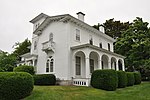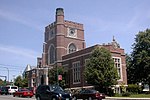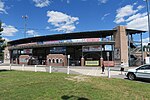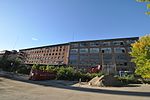Nashville Historic District (Nashua, New Hampshire)

The Nashville Historic District in Nashua, New Hampshire is a historic district that was listed on the National Register of Historic Places (NRHP) in 1984. It encompasses an area just north of downtown Nashua, roughly centered on the junction of Concord, Amherst, and Main streets. Its southern bound is the Nashua River and Railroad Square, its eastern bounds are Railroad Square, Clinton, Lock, Orange, and Concord streets, its northern bound is Mount Pleasant Street, and its western boundary is Abbott, Amherst, Concord, and Main streets between the northern and southern bounds.Today this area is known as French Hill, but the NRHP district takes its name from a time in the 19th century when the area was briefly separated from Nashua as the town of "Nashville". This was due to the placement of a new Town Hall in the southern half of the city (which was more populated at the time). The northern contingent split themselves off, calling themselves "Nashville". The split came only six years after the town had renamed itself "Nashua", in 1836. The creation of a new railroad line from Lowell, Massachusetts, that ran along the northern length of the Nashua River had resulted in Union Square being renamed "Railroad Square" in 1838.However, the railroad brought new economic prosperity and increased communication with Boston, and in 1853 the two town committees resolved their differences and a new town charter for the "City of Nashua" was enacted.
Excerpt from the Wikipedia article Nashville Historic District (Nashua, New Hampshire) (License: CC BY-SA 3.0, Authors, Images).Nashville Historic District (Nashua, New Hampshire)
Concord Street, Nashua
Geographical coordinates (GPS) Address Nearby Places Show on map
Geographical coordinates (GPS)
| Latitude | Longitude |
|---|---|
| N 42.768888888889 ° | E -71.466388888889 ° |
Address
Concord Street 31
03064 Nashua (Ward 3)
New Hampshire, United States
Open on Google Maps











